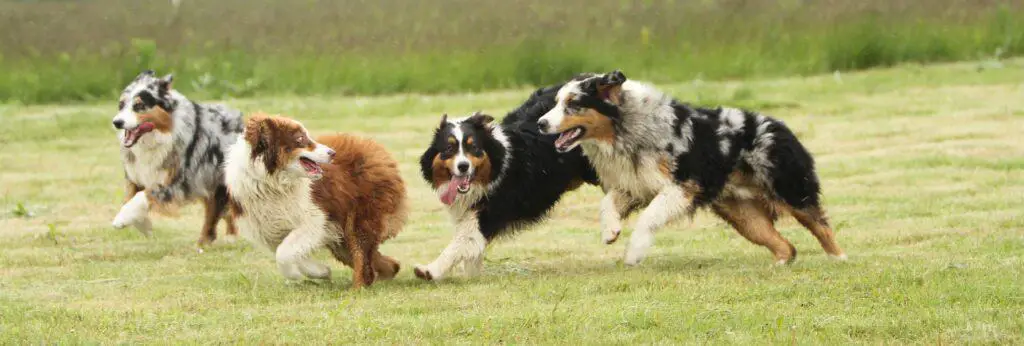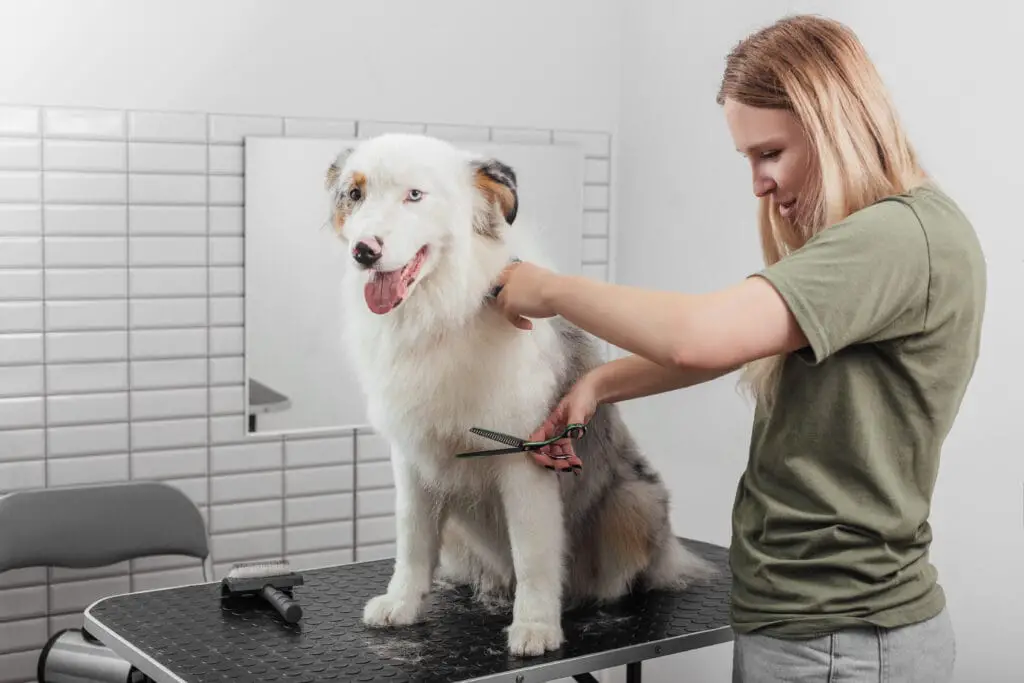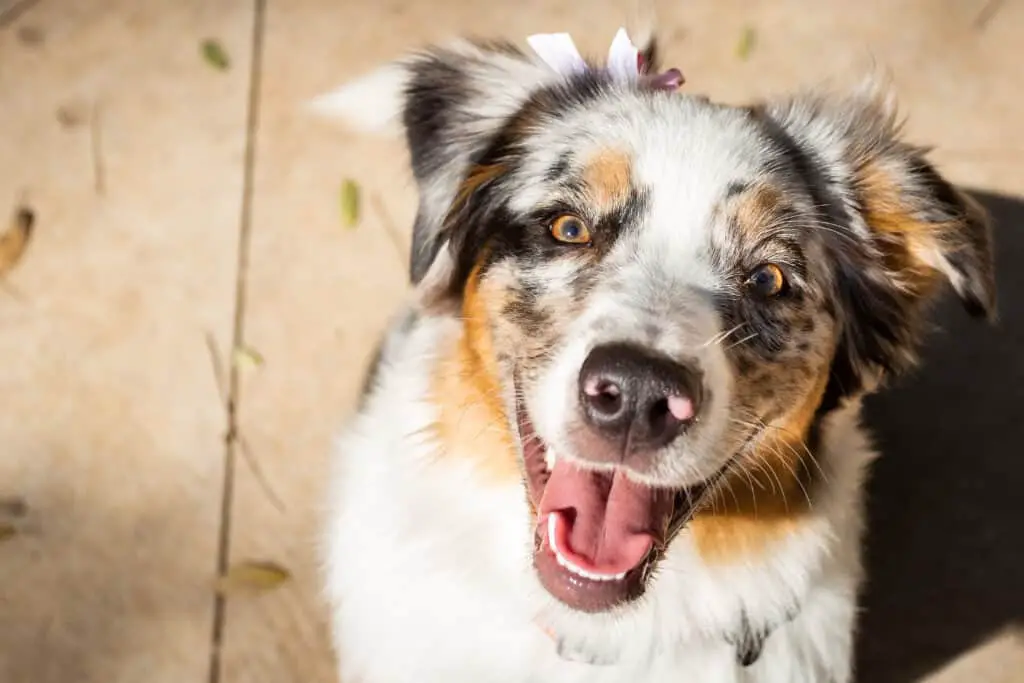Our website is supported by our users. We sometimes earn money when you click an affiliate link and make a purchase. This is at no extra cost to you and helps us to create quality content. Thank you for your support. For all that have shown us such wonderful support, we thank you from the bottom of our hearts!
The Australian Shepherd is a breed steeped in a rich history and an embodiment of the rugged, spirited work ethic of American herding dogs.
Despite the name, this energetic and intelligent breed did not originate in Australia, but rather in the western United States.
They are renowned for their versatility, agility, and a high level of energy, making them an ideal companion for an active lifestyle.
With a medium-sized stature, the Australian Shepherd is as robust and adaptable in the field as it is in a family environment, reflecting the breed’s herding heritage and stamina.

Their ability to learn quickly and respond well to training has helped the Australian Shepherd excel in various canine sports and occupations, from search and rescue to acting as affectionate and protective family pets.
While their boundless energy and keen intellect require plenty of mental and physical stimulation, the time and effort invested in training is often met with an impressive level of obedience and companionship.
Owning an Australian Shepherd is a rewarding experience that connects you to a tradition of pastoral craftsmanship fine-tuned on American soil but appreciated worldwide.
Key Takeaways
- The Australian Shepherd is a highly active and intelligent breed known for its agility and herding capabilities.
- Originating in the United States, the breed is well-suited for various roles from working on ranches to being a family pet.
- Training and regular exercise are crucial to channeling the Australian Shepherd’s energy and maintaining their mental and physical health.
History of the Australian Shepherd
Despite the name, your Australian Shepherd did not originate in Australia but has strong ties to the United States, specifically California.
This breed was actually developed in America during the 19th century, and elements of the breed’s origin trace back to the Basque region of Spain.
The lineage of the Australian Shepherd is somewhat eclectic, with the breed’s ancestors having been associated with Basque shepherds who migrated to America after temporarily residing in Australia.
During your research, you might discover that the American Kennel Club acknowledges the influence of various herding dogs on the breed’s development, including those used in rodeos.
Americans quickly took to the breed for its versatility and herding skill.

The breed’s association with ranching and rodeos in California solidified its presence in American culture.
It’s important to note that despite these dogs being called Australian Shepherds, they became a distinct breed in America.
They were particularly helpful as herders and gained popularity through their impressive performances at rodeos.
| Key Point | Detail |
|---|---|
| Origin | America/California, not Australia |
| Legacy | Rodeo performer, herder |
| Development | Mixture of European herding dogs, mainly from Spain |
| Recognition | American Kennel Club |
| Cultural Impact | Became a symbol of American ranching culture |
Your Australian Shepherd’s history is a tapestry woven from various cultures and continents, reflecting a storied past that merits pride for this intelligent and capable breed.
Physical Characteristics

The Australian Shepherd is a muscular and high-energy dog breed, known for its unique coat patterns and striking eye colors.
These dogs possess a double coat that comes in a variety of colors and have a physical build that reflects their energetic lifestyle.
Height Male
Male dogs typically stand at about 20 to 23 inches tall.
Height Female
Females are usually 18 to 21 inches in height.
Weight Male
A male Australian Shepherd usually weighs between 50 to 65 pounds.
Weight Female
For females, the weight range is slightly less, around 40 to 55 pounds.
Eye Colors
Your Aussie’s eyes may be blue, brown, amber, or even green. Heterochromia, where each eye is a different color, is also common in this breed.

Coat Colors
You’ll find Aussies in black, red, blue merle, and red merle. Each of these colors may include white markings and/or tan (copper) points.
Coat Types
Australian Shepherds boast a medium-length double coat. This variety provides insulation and requires regular grooming to maintain its condition.
Life Expectancy
Understanding the life expectancy of your Australian Shepherd is crucial for providing long-term care.
Typically, an Australian Shepherd has a lifespan that ranges from 12 to 15 years.
This duration aligns with the breed’s medium size and active nature, indicating a relatively long and vibrant lifespan for a dog.
Key factors that influence your Australian Shepherd’s longevity include:
- Genetics: Predispositions to certain health conditions.
- Diet and Nutrition: Quality of diet directly affects overall health.
- Exercise: Adequate daily exercise is vital for maintaining good health.
- Regular Vet Checkups: Essential for early detection of health issues.
Here are a couple of insights into their lifespan to keep in mind:
- Maintaining Body Condition: Australian Shepherds should have a well-managed weight to lessen the burden on their joints.
- Mental Health: Keeping your Aussie mentally stimulated can also have a positive effect on their lifespan.
It is known that Aussie Dogs may be prone to certain health conditions.
Understanding these risks and providing preventive care can help extend their life expectancy.
To dive deeper into potential health issues for this breed, reviewing Australian Shepherd Dog Breed Health and Care may be beneficial.
Remember, providing love and attention is as crucial as any other care strategy for the health and happiness of your Australian Shepherd.
Temperament & Training
The Australian Shepherd, affectionately known as the Aussie, exhibits a temperament befitting their herding heritage.
They are intelligent, loyal, and protective, making them superb family companions.
This breed thrives when it has a job to do, embodying an active and playful demeanor.
Temperament:
- Intelligence: Australians Shepherds are super intelligent dogs that are capable of learning complex tricks and commands.
- Loyal: Their loyalty to their family is unwavering.
- Protective: A natural guardian instinct makes them alert and watchful.
- Energetic: Active dogs with high energy levels necessitate high levels of physical exercise.
- Playful: Aussies love engaging in playful activities, keeping their spirits high.

Training:
- Obedience: Firm, consistent training from an early age encourages good behavior.
- Agility: Their agile nature makes them excellent at agility training.
- Herding Instincts: Utilize their natural herding instincts in training activities for mental stimulation.
- Mental Stimulation: Keeping their intelligent minds engaged prevents destructive behavior.
- Hearing: Aussies are responsive to vocal commands, and consistent training enhances their hearing obedience.
While training your Australian Shepherd, remember that a positive reinforcement approach is most effective.
Your Aussie requires both physical and mental exercise to prevent them from becoming destructive.
Their herding instincts may lead them to nip at heels; redirect this behavior through specific training exercises.
Your Aussie’s loyal and protective nature makes them excellent at following commands and looking after their home.
Regular training sessions will enhance their natural skills and ensure they remain well-behaved and content.
Given their energy and intelligence, Australian Shepherds excel in a variety of canine sports, including agility, obedience, and herding trials.
In addition to being full-service mobility dogs, Australian Shepherds can be trained for therapy, search and rescue, companionship with the disabled and even guide dogs for the blind.
Discipline combined with affection will ensure that your Aussie is both a well-mannered pet and an enthusiastic participant in your active life.
Health Issues
When considering an Australian Shepherd as your companion, you should be aware of certain health issues that are commonly associated with the breed.
Eye Conditions: It’s vital to monitor your Australian Shepherd for eye problems, which include:
- Cataracts can lead to cloudiness in the lens and potentially cause blindness if untreated.
- Progressive Retinal Atrophy (PRA) is a degenerative condition that gradually causes blindness.
- Collie Eye Anomaly is a developmental disorder that can range from mild to severe, possibly leading to retinal detachment.
Genetic Considerations:
- Merle Gene: Carriers of the homozygous merle gene may be at increased risk for deafness and vision problems.
- Hip and Elbow Dysplasia: This is an inherited condition where the joints develop improperly and can lead to pain and mobility issues.
Neurological Disorders:
- Epilepsy can be a concern for your dog, causing recurrent seizures that may require lifelong management.
Other Health Concerns:
- Hypothyroidism affects your dog’s metabolism, often treatable with medication.
- Due to Multiple Drug Sensitivity (MDR1), your Aussie might show adverse reactions to certain drugs.
Remember, regular veterinary check-ups and genetic testing can help in early detection and treatment to ensure your dog lives a happy, healthy life.
Grooming Your Australian Shepherd
Proper grooming is essential for maintaining the health and appearance of your Australian Shepherd.
This breed is known for its thick double coat that requires regular care, especially during shedding season.
Brushing
You should brush your dog’s coat daily to prevent mats and tangles, especially during the peak shedding seasons.
Utilize a slicker brush or an undercoat rake to remove loose fur and distribute natural oils throughout the coat.
Bathing
Bathing is typically necessary every few months, unless your dog gets particularly dirty.
Use a dog-specific shampoo that caters, and ensure you rinse thoroughly to avoid residue that can irritate the skin.
This massager really gets the soap and all of it’s soothing ingredients down through all your dog’s thick fur.

Cutting Fur/Hair
Trimming the hair around the ears, paws, and rear end can keep your Australian Shepherd looking neat.
Do not cut the double coat drastically, as it protects your dog from weather extremes.
You may want to trim around your dog’s sanitary areas. We recommend this grooming set or these clippers to help with that.
Clipping or Grinding Nails
Keep your dog’s nails at a comfortable length, typically trimming or grinding at least once a month.
Be cautious not to cut into the quick, which can cause bleeding.
Clip or grind their nails as needed, usually once or twice a month, being careful not to cut into the quick, which can cause bleeding.
If you accidentally cut the quick, dip their nails in Styptic Powder.
If you are nervous about trimming your dog’s nails, check out our article on How to Grind Your Dog’s Nails.
And How to Clip Your Dog’s Nails Safely.
Dental Care
Brush your dog’s teeth several times a week with dog toothbrush and toothpaste to promote good oral hygiene and prevent dental diseases.
Start slowly and make it a positive experience for your dog.
Cleaning Ears
Examine and clean your dog’s ears regularly to prevent infection.
Use a vet-approved ear cleaner and gently wipe out any debris or excess wax, avoiding deep insertion into the ear canal.
You can use the Pet MD – Dog Ear Cleaner Wipes – Otic Cleanser for Dogs for an easy fix.
Remember, grooming is not only about keeping your dog’s coat manageable but also about checking for signs of skin issues or parasites.
Regular grooming sessions are a cornerstone of good care, ensuring your dog stays comfortable and healthy.
Owning an Australian Shepherd
When owning an Aussie you’re committing to both a financial investment and the responsibility of caring for an active and intelligent dog.
Recognizing the cost factors and sources like breeders or shelters can help ensure a smooth integration of your new pet into your home.
Cost of Purchase
The initial expense of your dog can vary widely based on the dog’s lineage, age, and the breeder’s reputation.
Generally, purchasing from reputable breeders registered with the American Kennel Club or the Australian Shepherd Club of America may cost anywhere from $600 to $1,800. Purebred show-quality Aussies could command even higher prices.
Maintenance Costs Including Special Training, Medical Costs, Grooming
Aside from the purchase price, there are ongoing maintenance costs to consider for your Australian Shepherd’s care:
- Training: They require consistent training due to their intelligence and energy levels. Specialized training costs can range from $50 to $200 per session.
- Medical: Routine medical expenses such as vaccinations, check-ups, and spaying/neutering should be anticipated, averaging around $500 to $700 annually.
- Grooming: Given their thick double coats, regular grooming is essential, potentially costing $60 to $80 per session.
Creating a budget for your Aussie’s needs is advisable to avoid any unexpected financial burden.
Adopting an Australian Shepherd
Adopting an dog from shelters or rescue organizations can be a cost-effective and fulfilling option.
Adoption fees typically cover initial medical costs like spaying/neutering, vaccinations, and microchipping, ranging from $150 to $400.
It’s crucial to verify that your dog’s behavioral needs align with your lifestyle.
Finding Reputable Breeders
To ensure a healthy Australian Shepherd puppy, you should seek breeders with clearances proving their dogs are screened for genetic conditions.
Breeders endorsed by the Australian Shepherd Club of America or local kennel clubs are ideal choices.
They should welcome your visit to see the puppies and their living conditions, providing a transparent window into your future pet’s early life.
Frequently Asked Questions
In this section, you’ll find answers to some of the most common inquiries regarding Australian Shepherds, a breed known for its intelligence and energy.
What is the typical lifespan of an Australian Shepherd?
You can expect your dog to have a lifespan of around 12 to 15 years, which is quite standard for a dog of its size and breed.
What are the common coat colors for Australian Shepherds?
Your dog’s coat can come in a variety of common colors including black, blue merle, red, and red merle.
Each coat color can have its own pattern and may include white markings or tan points.
How much do Australian Shepherds usually weigh?
A typical female Australian Shepherd weighs between 40 and 55 pounds, while males are generally in the range of 50 to 65 pounds.
These weights can vary depending on the individual dog’s diet and level of activity.
What is the standard size for a Mini Australian Shepherd?
The Mini Australian Shepherd usually stands about 14 to 18 inches tall at the shoulder.
It’s a smaller version of the standard breed but maintains a similar herding dog build and active temperament.
How does the Australian Shepherd rank in terms of friendliness towards families and children?
Australian Shepherds are known for their loyalty and protective nature, making them excellent companions for families and generally friendly towards children.
It’s important to socialize them from a young age to ensure they’re well-adjusted.
What are some tips for effectively training an Australian Shepherd?
For successful training of your Australian Shepherd, begin with a strong foundation of trust and use positive reinforcement techniques.
Consistency, patience, and regular exercise are key to keeping them engaged and responsive to training.
Conclusion: Bottom Line on the Australian Shepherd

When evaluating the Australian Shepherd, you’ll find that they embody a mix of loyalty, intelligence, and energy.
As a herding breed, they possess an innate drive to work and are highly regarded for their versatile skills in protection and farm work.
Character Traits:
- Loyal: Your Australian Shepherd is likely to form strong bonds with you and your family.
- Intelligent: Training is usually a rewarding experience due to their quick learning ability.
- Active: An athletic lifestyle is essential for these energetic dogs.
Australian Shepherds are enthusiastic and thrive when they have a job to do, making them perfect companions for an active lifestyle. Their herding instinct also means they may attempt to herd children or other pets, which is an instinct that can be channeled through proper training and activities.
Health & Care:
- Health Concerns: Be aware that the breed can face specific health issues, including hip dysplasia and certain eye conditions.
- Life Expectancy: With good care, Australian Shepherds have a life expectancy between 12 to 15 years.
Your commitment to regular exercise and mental stimulation will go a long way in maintaining your dog’s happiness and well-being.
Adaptable to various living situations, Australian Shepherds make great pets for families willing to meet their high level of activity and engagement.
Given these aspects, your decision to welcome an Australian Shepherd into your home should include considerations for space, energy levels, and the capacity to provide ongoing mental and physical stimulation that aligns with this breed’s vibrant character.
Please read our Legal Disclaimer









